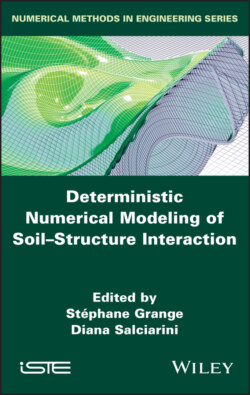Deterministic Numerical Modeling of Soil Structure Interaction

Реклама. ООО «ЛитРес», ИНН: 7719571260.
Оглавление
Группа авторов. Deterministic Numerical Modeling of Soil Structure Interaction
Table of Contents
List of Illustrations
List of Tables
Guide
Pages
Deterministic Numerical Modeling of Soil–Structure Interaction
Introduction
1. Hydro-mechanically Coupled Interface Finite Element for the Modeling of Soil–Structure Interactions: Application to Offshore Constructions
1.1. Introduction
1.1.1. The finite element method (FEM)
1.1.2. Review of existing contact formulations
1.1.3. Objectives
1.2. Governing equations of the interface problem
1.2.1. Mechanical problem. 1.2.1.1. Definition of the mechanical problem and gap function
1.2.1.2. Normal contact constraint
1.2.1.3. Tangential contact constraint
1.2.1.4. Constitutive law
1.2.1.5. Continuum formulation
1.2.2. Flow problem. 1.2.2.1. Definition of the problem
1.2.2.2. Fluid flow formulation
1.2.2.3. Continuum formulation
1.2.3. Couplings between mechanical and flow problems
1.3. Numerical formulation of the element
1.3.1. Space and fluid pressure discretization
1.3.2. Mechanical problem. 1.3.2.1. Local system of coordinates and gap function
1.3.2.2. External energetically equivalent nodal forces
1.3.3. Flow problem. 1.3.3.1. Internal energetically equivalent nodal forces
1.3.3.2. External energetically equivalent nodal forces
1.3.4. Time discretization
1.3.5. Stiffness matrix
1.4. Application
1.4.1. Suction caissons
1.4.2. Problem description
1.4.3. Tension loading. 1.4.3.1. Drained simulation (mechanical problem)
1.4.3.2. Partially drained simulation (coupled problem)
1.4.3.3. Comparison with other authors
1.4.3.4. Loading/unloading cycle
1.4.4. Lateral loading
1.4.4.1. Drained simulation (mechanical problem)
1.4.4.2. Partially drained simulation (coupled problem)
1.5. Conclusion and perspectives. 1.5.1. Conclusion
1.5.2. Perspectives
1.6. References
2. DEM Approach of the Modeling for Geotechnical Structures in Interaction with Reinforcements
2.1. Introduction
2.2. Discrete modeling. 2.2.1. General concepts of the discrete modeling approach
2.2.2. Specific interaction between discrete particles and reinforcement elements
2.2.3. Numerical strategy for geotechnical structure modeling using DEM
2.3. Application of the DEM to geotechnical structures in interaction with rigid piles
2.3.1. Load transfer mechanisms within granular embankments over a network of piles
2.3.2. Load transfer mechanisms within granular embankments over a network of piles under cyclic loadings
2.4. Application of the DEM to geotechnical structures in interaction with flexible and deformable reinforcement – comparison with experiment results
2.4.1. Numerical and experimental behavior of geosynthetic tubes filled with granular material
2.4.2. Numerical and experimental behavior of granular embankments reinforced with geosynthetic in areas prone to subsidence
2.5. Conclusion
2.6. References
3. SSI Analysis in Geotechnical Engineering Problems Using a Finite Difference Method
3.1. Introduction
3.2. The finite difference method using an explicit scheme
3.3. Application of the finite difference method to soil–structure interaction problems
3.3.1. Structural elements
3.3.2. Interfaces
3.3.3. Constitutive models for soil
3.3.4. Dimension of the problem
3.3.5. Monotonic, quasi-static cyclic and dynamic loadings
3.4. Some application examples in the geotechnical engineering field
3.4.1. Reinforced retaining walls
3.4.2. Tunneling. 3.4.2.1. Tunneling in soft ground and interaction with adjacent structures
3.4.2.2. Tunnel face reinforcement
3.4.2.3. Tunnels under seismic loading
3.4.3. Soft soil improvement using vertical rigid piles
3.5. Conclusion
3.6. References
4. Macroelements for Soil–Structure Interaction. 4.1. Introduction
4.2. The concept of generalized forces: Eurocode 8 recommendations
4.3. Macroelements for shallow foundations. 4.3.1. Generalities
4.3.2. Macroelements formulated in the framework of hardening elastoplasticity
4.3.3. Macroelements formulated in the framework of hypoplasticity
4.4. The considered macroelements
4.4.1. The elastoplastic macroelement
4.4.2. The hypoplastic macroelement
4.5. Case study: seismic response of a reinforced concrete viaduct
4.5.1. Features of the viaduct
4.5.2. The finite element model of the viaduct and its foundations
4.5.3. Seismic input
4.6. Calibration of the macroelements
4.7. Results of the numerical simulations
4.7.1. Forces and displacements in the structural elements
4.7.2. Displacements of the abutment and the foundations
4.8. Concluding remarks
4.9. References
5. Urban Seismology: Experimental Approach to Soil–Structure Interaction Towards the Concept of Meta-city. 5.1. Introduction
5.1.1. Observation of soil–structure interaction under weak and strong seismic loading. 5.1.1.1. Analytic model for a 1-DOF system
5.1.1.2. Frequency analysis of motion components of the soil–structure system
5.1.1.3. Cross-interaction between soil and structure
5.1.1.4. Interactions between structures
5.1.2. Contamination of urban seismic motion by the vibration of buildings
5.1.3. Conclusion
5.2. References
List of Authors
Index. C, D, F
G, H, I
L, M, N
O, P, R, S
T, U, W
WILEY END USER LICENSE AGREEMENT
Отрывок из книги
Series Editor
.....
Edited by
Stéphane Grange
.....